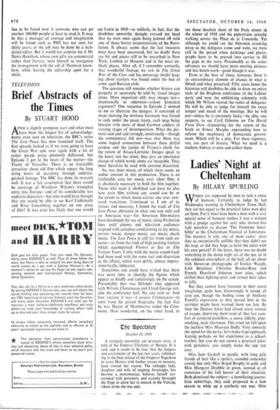Brief Abstracts of the Times
TELEVISION
By STUART HOOD
AFTER a slightly pompous start and what must have been the longest list of acknowledge- ments even seen on television, the BBC's series The Lost Peace has now launched itself. The first episode looked as if we were going to have the Great War epic over again with a lot of rather purple prose plummily delivered; but Episode 2 got to the heart of the matter—the Treaty of Versailles. There is an irresistible attraction about old film which repays the long tiring hours of searching through undistin- guished footage. The BBC has done its research well. It was a fair assumption that there would be coverage of Woodrow Wilson's triumphal entry into Europe—and of his considerably less euphoric departure—but who would have thought that one would be able to see Karl Liebknecht and Rosa Luxemburg together on one piece of film? It was even less likely that one would
see Lenin in 1918—so unlikely, in fact, that the doubtless unworthy thought crossed my head that we were once again being palmed off with one of those Soviet reconstructions of the Revo- lution. It always seems that the last treasures must have been uncovered, but no doubt there are bit and pieces still to be unearthed in New York, London or Moscow and in the most un- likely places. After all, if I remember correctly, that wonderful footage we saw in The Great War of the Czar and his entourage (male) leap- ing about starkers was found- under the bed of some aged Russian exile.
The question still remains whether history can properly or accurately be told by visual images alone. More important still, may images not— intentionally or otherwise—colour historical argument? One sequence in Episode 2 seemed to me to illustrate the dangers. It consisted of maps showing the territory Germany was forced to cede under the peace treaty, each map being intercut with shots of dead German soldiers in varying stages of decomposition. What the pic- tures said and said strongly, emotionally—though the commentary did not—was that there was some logical connection between these pitiful corpses and the justice of France's claim for the return of Alsace-Lorraine. Images speak to the heart, not the mind; they give an emotional charge of which words alone are incapable. They must therefore be used with extreme discretion.
So, too, must music, of which there seems an undue amount in this production. There is an irrefutable case for music over silent film; it is absolutely necessary to hold the film together. Those who want it abolished can have no idea how eerie film without any sound can be or the extent to which music carries one over awk- ward transitions. Convinced as I am of its virtues and necessity, I found the track of The Lost Peace obtrusive in what one can only call an American way—for American film-Makers have developed the use of music along Pavlovian lines until cinema and television audiences respond with complete conditioning to joy music, sorrow music, danger music, sex music, death music. The Lost Peace is still far from such ex- cesses—or from the kind of high-peaking fanfare which accompanied Victory at Sea or The Valiant Years. I only wish the music sound-track had been used with the same tact and discretion as the effects, which were deftly, almost impres- sionistically, indicated.
Sometimes one could have wished that there was more time to identify the figures which appear so briefly and tantalisingly on the screen. Presumably that was Orlando who appeared with Wilson, Clemenceau and Lloyd George out- side the conference hall. No one said so. And how curious it was—ii propos Clemenceau—to omit from his potted biography the fact that he was Mayor of Montmartre under the Com- mune. How wonderful, on the other hand, to see those desolate shots of the Paris streets in the winter of 1918 and the pedestrians actually walking across the Place de la Concorde. Yet although we could see the film-men cranking away as the delegates came and went, we were still in the period when paintings and photo- graphs have to be pressed into service to fill the gaps in the story. Presumably as the series advances we should have more moving pictures and less bench-work—good though it was.
Even at the best of times, however, there is an extraordinary element of chance in what is filmed and what preserved. Fifty years hence the historian will doubtless be able to draw on entire reels of the Brighton conference of the Labour party and note the unblinking solemnity with which Mr Wilson viewed the ranks of delegates. He will be able to judge for himself the exact temper and mood of the meetings. But he will not—unless he is extremely lucky—be able, one suspects, to see Cyril Osborne on The David Frost Show clamouring for the return of the birch or Ernest Marples expounding how to reform the machinery of democratic govern- ment. Which will be a pity. For these vignettes, too, are part of history. What we need is a Modern Aubrey to note and collect them.






































 Previous page
Previous page